Accessibility is not just about making life easier for people with disabilities—it is about designing spaces, products, and services that work for everyone. Universal design is the key to creating an inclusive world where people of all abilities can participate fully without barriers. Whether it’s a wheelchair-accessible building, a user-friendly smartphone, or a public space that accommodates all, universal design ensures that no one is left behind.
By focusing on flexibility, simplicity, and inclusivity, universal design makes everyday experiences more convenient for everyone, including the elderly, parents with strollers, and people recovering from injuries. In this article, we will explore how universal design is transforming cities, workplaces, technology, and daily life, and why it is essential for a more accessible future.
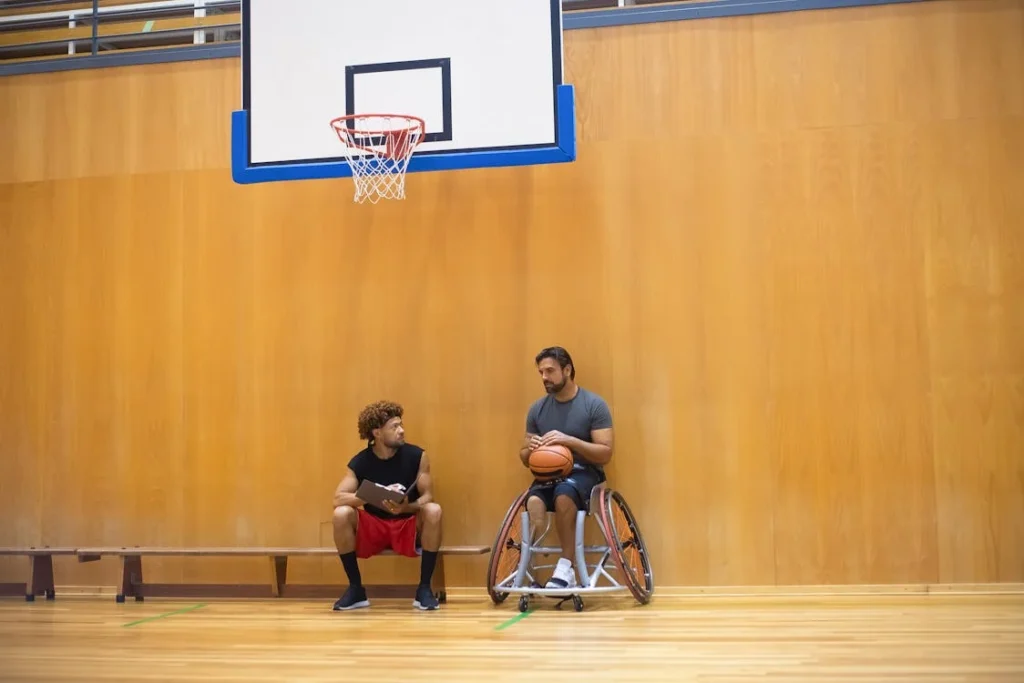
Understanding Universal Design and Its Core Principles
Universal design is the concept of creating environments, products, and services that are accessible to everyone, regardless of age, ability, or background.
Unlike traditional accessibility solutions, which often involve modifying existing structures to accommodate people with disabilities, universal design focuses on inclusivity from the beginning.
It ensures that spaces and products work for all users, eliminating the need for costly retrofitting or special accommodations later on.
The foundation of universal design lies in a few key principles that guide architects, designers, and businesses in creating accessible solutions.
One of the most important principles is equitable use, which means that a product or space should be usable by all people in the same way, without requiring separate designs or alternative solutions.
For example, automatic doors benefit not just wheelchair users but also parents pushing strollers and people carrying heavy bags.
Another critical principle is flexibility in use, which allows users to interact with a product or environment in multiple ways. Adjustable-height desks, which can accommodate both standing and seated users, are a great example of this principle in action.
Similarly, voice-controlled technology enables people with visual impairments, mobility challenges, or even temporary injuries to operate devices without difficulty.
Simple and intuitive design ensures that products and environments are easy to understand and use, regardless of a person’s experience, literacy level, or cognitive ability.
This is why icons and clear visual cues are commonly used in public spaces instead of complex written instructions. An elevator with large, well-labeled buttons, for instance, makes navigation easier for everyone, including people with vision impairments or limited dexterity.
Another essential principle is tolerance for error, which ensures that designs minimize the risk of mistakes and allow for easy corrections.
This is particularly important in digital accessibility, where features like undo buttons and confirmation messages prevent users from making irreversible errors.
Finally, low physical effort is a key aspect of universal design.
Whether it’s a door that opens with a light push or a faucet that turns on with a simple motion sensor, reducing the amount of physical strain required to interact with everyday objects benefits a wide range of people, including older adults and those with mobility challenges.
How Universal Design Is Transforming Public Spaces
One of the most visible ways universal design is shaping a more accessible world is through its impact on public spaces. Cities, transportation systems, and commercial buildings are being designed with inclusivity in mind, ensuring that people of all abilities can navigate them easily.
Modern city planning now prioritizes features like curb cuts, which allow smooth transitions between sidewalks and streets for wheelchair users, cyclists, and parents with strollers.
Well-designed pedestrian crossings include audio signals to assist visually impaired individuals, while ramps and elevators ensure that public buildings are accessible to everyone.
Public transportation is also benefiting from universal design. Buses with low floors, tactile paving at train stations, and clear digital announcements in multiple formats—visual, auditory, and text—allow a diverse range of passengers to travel independently.
These small changes make a significant difference in improving mobility and freedom for individuals with disabilities.

The Impact of Universal Design in Workplaces and Education
Universal design is not just about public spaces—it is also transforming workplaces and schools, making them more inclusive and accessible for everyone.
A well-designed environment ensures that employees and students of all abilities can participate fully without unnecessary barriers.
This shift is not just about compliance with accessibility laws; it is about creating a culture of inclusion that benefits productivity, creativity, and overall well-being.
How Universal Design Creates Inclusive Workplaces
In modern workplaces, universal design is helping companies accommodate employees with different needs.
Flexible workstations, height-adjustable desks, and ergonomic office chairs provide comfort for individuals with mobility challenges, back pain, or other physical conditions.
Voice-activated assistants and screen readers allow employees with visual impairments to use computers efficiently, while sign language interpreters or captioning software make meetings accessible to those with hearing impairments.
One of the most significant advancements in workplace accessibility is the growing use of remote work technologies. Virtual meetings, cloud-based collaboration tools, and digital workspaces make it easier for employees with disabilities to work from home if needed.
These technologies benefit not only people with disabilities but also individuals with temporary injuries, parents with caregiving responsibilities, and employees who need a more flexible schedule.
Additionally, the physical layout of an office can greatly impact accessibility. Open spaces with wide corridors, automatic doors, and barrier-free restrooms make it easier for employees who use wheelchairs or mobility aids to move around freely.
Well-lit rooms and high-contrast signage help employees with visual impairments navigate office spaces more comfortably.
Universal Design in Education: Making Learning Accessible for All
Schools and universities are also adopting universal design principles to create inclusive learning environments. A well-designed classroom ensures that students with disabilities can learn alongside their peers without feeling excluded.
One of the most important aspects of universal design in education is providing multiple ways for students to access information.
Textbooks in digital formats, audio lectures, and real-time captions during classes help students with visual or hearing impairments keep up with their coursework.
Interactive technology, such as touchscreens and speech-to-text software, allows students with different learning needs to engage with material in a way that works best for them.
Classroom furniture and layouts also play a crucial role in accessibility. Adjustable-height desks, flexible seating arrangements, and accessible lab stations ensure that students of all abilities can comfortably participate in lessons.
Even something as simple as ensuring that writing boards are positioned at an appropriate height can make a significant difference for students with mobility challenges.
Exams and assessments are also becoming more inclusive through universal design. Some schools now allow students to take tests in different formats, such as oral exams, multiple-choice options, or extended time for written responses.
This ensures that students with different learning styles and disabilities are evaluated fairly based on their knowledge rather than their ability to complete traditional written exams.
As universal design principles continue to be adopted in workplaces and educational institutions, more individuals with disabilities will have the opportunity to thrive in professional and academic settings without unnecessary obstacles.
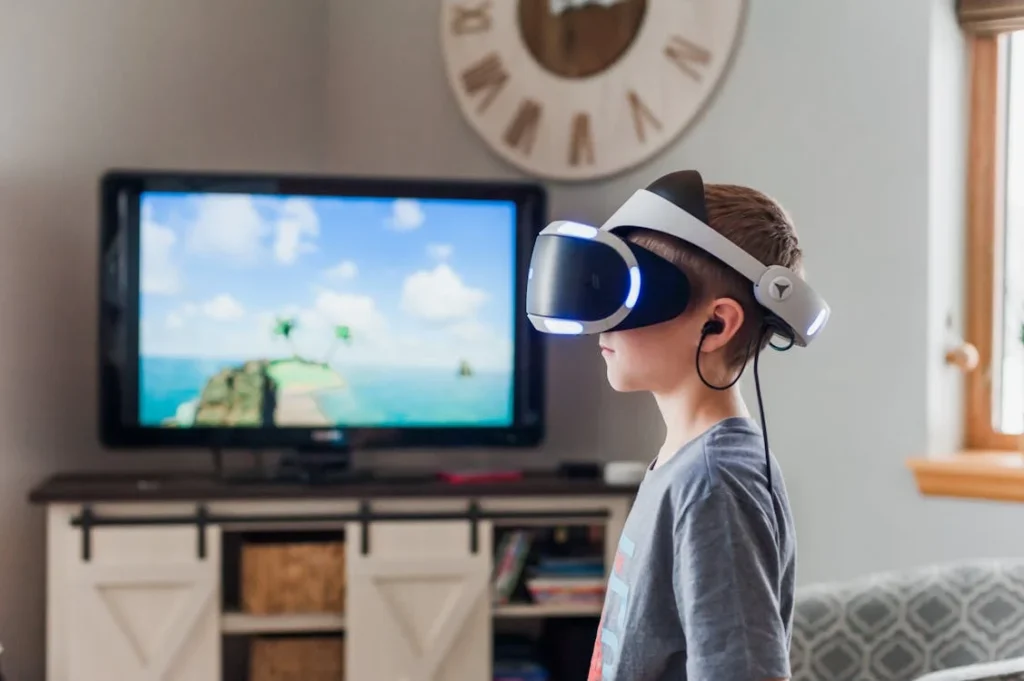
The Role of Universal Design in Technology and Digital Accessibility
Technology is one of the most powerful tools for creating an accessible world, and universal design is at the heart of this transformation.
Whether it is smartphones, websites, or smart home devices, well-designed technology ensures that people of all abilities can interact with digital platforms without difficulty.
When accessibility is built into technology from the start, it eliminates the need for later modifications and provides a seamless experience for everyone.
How Universal Design Improves Digital Accessibility
The internet is an essential part of daily life, but for people with disabilities, navigating websites and online services can be challenging if they are not designed with accessibility in mind.
Universal design in digital spaces means making websites, apps, and online platforms usable for people with visual, hearing, mobility, or cognitive impairments.
One of the most important aspects of digital accessibility is screen reader compatibility. Screen readers are software programs that convert text into speech, allowing individuals with vision impairments to access digital content.
Websites designed with proper headings, alt text for images, and keyboard-friendly navigation ensure that screen readers can interpret the content accurately.
Captioning and transcripts also play a crucial role in making digital content accessible. Videos with closed captions help individuals with hearing impairments follow along, while written transcripts provide an alternative way to consume audio-based content.
Many streaming platforms, online courses, and virtual meetings now include automatic captioning features to ensure inclusivity.
For individuals with mobility impairments, voice commands and adaptive input methods are game-changers.
Smartphones and computers now include built-in voice assistants, allowing users to send messages, browse the internet, and control their devices without needing to use a keyboard or touchscreen.
Eye-tracking technology is another breakthrough that enables users with limited hand mobility to navigate screens simply by moving their eyes.
The Role of Smart Technology in Accessibility
Smart home technology is another area where universal design is making life easier for people with disabilities. Voice-activated assistants, automated lighting, and remote-controlled appliances provide convenience and independence for individuals with mobility challenges.
A person who has difficulty using traditional light switches can turn lights on and off using voice commands or an app. Similarly, smart thermostats allow users to adjust temperature settings without needing to physically reach a control panel.
Wearable technology is also contributing to accessibility improvements. Smartwatches with built-in health monitoring features help individuals with disabilities track their heart rate, detect falls, and send emergency alerts when needed.
Some wearable devices provide haptic feedback (vibrations) to assist individuals with hearing impairments in recognizing notifications or alerts.
Making Social Media and Online Communication More Inclusive
Social media platforms are adopting universal design principles to ensure that everyone can engage in online conversations.
Features such as voice-to-text messaging, high-contrast visual settings, and customizable font sizes help users with different accessibility needs participate in digital interactions.
Many platforms are also implementing AI-powered accessibility tools, such as automatic alternative text for images, which provides visually impaired users with descriptions of photos and graphics.
These advancements ensure that social media is not just a place for entertainment but also a space where people of all abilities can connect, share ideas, and build communities.
By integrating universal design into technology and digital spaces, companies and developers are helping to create a more inclusive world where no one is left behind.
As innovation continues, the goal should always be to make digital tools and online experiences accessible to everyone, regardless of physical ability or technical expertise.
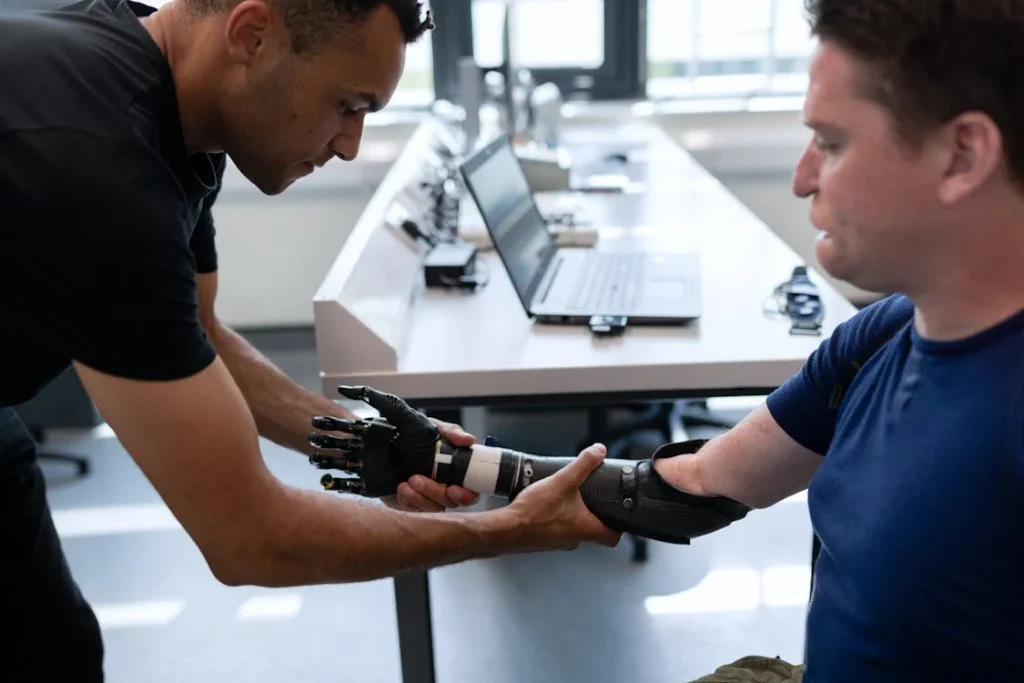
Universal Design in Healthcare and Assistive Technology
Healthcare is another critical area where universal design is improving accessibility, ensuring that medical services, equipment, and assistive technology are available to people of all abilities.
When healthcare facilities, medical devices, and prosthetic solutions are designed with inclusivity in mind, individuals with disabilities receive better care, experience fewer barriers, and gain greater independence.
Making Healthcare Facilities More Accessible
Hospitals, clinics, and rehabilitation centers must be designed with universal accessibility to provide effective care for all patients.
Simple but essential modifications—such as step-free entrances, wide hallways, and accessible restrooms—allow people who use wheelchairs or mobility aids to navigate medical facilities easily.
Elevators with braille buttons and voice announcements assist individuals with visual impairments, while clear signage and color-coded navigation systems help patients with cognitive challenges find their way.
For individuals with hearing impairments, healthcare providers are increasingly using text-based communication tools, live captioning, and sign language interpreters during medical consultations.
These adjustments ensure that patients can clearly understand their diagnosis, treatment options, and medication instructions without confusion.
One area that still needs improvement is the accessibility of medical examination equipment. Traditional examination tables, diagnostic machines, and dental chairs often require physical adjustments that can be difficult for individuals with limited mobility.
Universal design in healthcare technology aims to create height-adjustable tables, wheelchair-accessible diagnostic machines, and adaptive tools that provide better comfort and efficiency for both patients and medical professionals.
The Role of Assistive Technology in Universal Design
Advancements in assistive technology are helping people with disabilities regain independence and improve their quality of life. Universal design principles ensure that these devices are user-friendly, customizable, and widely available.
Prosthetics, for example, have evolved significantly in recent years. At Robobionics, we develop advanced prosthetic solutions like Grippy™, a bionic hand designed to provide natural movement and improved functionality.
By using lightweight materials and intuitive controls, prosthetics are becoming more adaptable, allowing users to perform daily tasks with greater ease.
Another important development is the rise of AI-powered assistive devices. Smart wheelchairs with obstacle detection and automated navigation make mobility safer and more efficient.
Eye-tracking communication devices enable individuals with severe disabilities to speak by simply looking at a screen, while AI-powered hearing aids automatically adjust to different sound environments, enhancing auditory clarity.
Wearable health monitors are also playing a role in universal design. Devices that track heart rate, blood pressure, and oxygen levels help individuals with chronic conditions manage their health more effectively.
Many of these wearables come with customizable alerts that notify users and caregivers of potential medical issues, providing an extra layer of safety.
The Future of Universal Design in Healthcare
The future of universal design in healthcare lies in greater personalization and automation. AI-driven diagnostics, telemedicine services, and robotic rehabilitation systems are making healthcare more accessible than ever before.
Virtual consultations allow patients to receive medical advice without traveling to a hospital, reducing the burden on individuals with mobility limitations.
Robotic therapy devices are being used in rehabilitation centers to assist patients recovering from injuries or neurological conditions, providing precise and consistent support.
As technology continues to evolve, healthcare providers must prioritize accessibility in every aspect of medical care.
Whether it’s designing inclusive hospitals, improving medical devices, or developing user-friendly assistive technology, universal design ensures that healthcare remains a fundamental right for all individuals, regardless of their physical abilities.
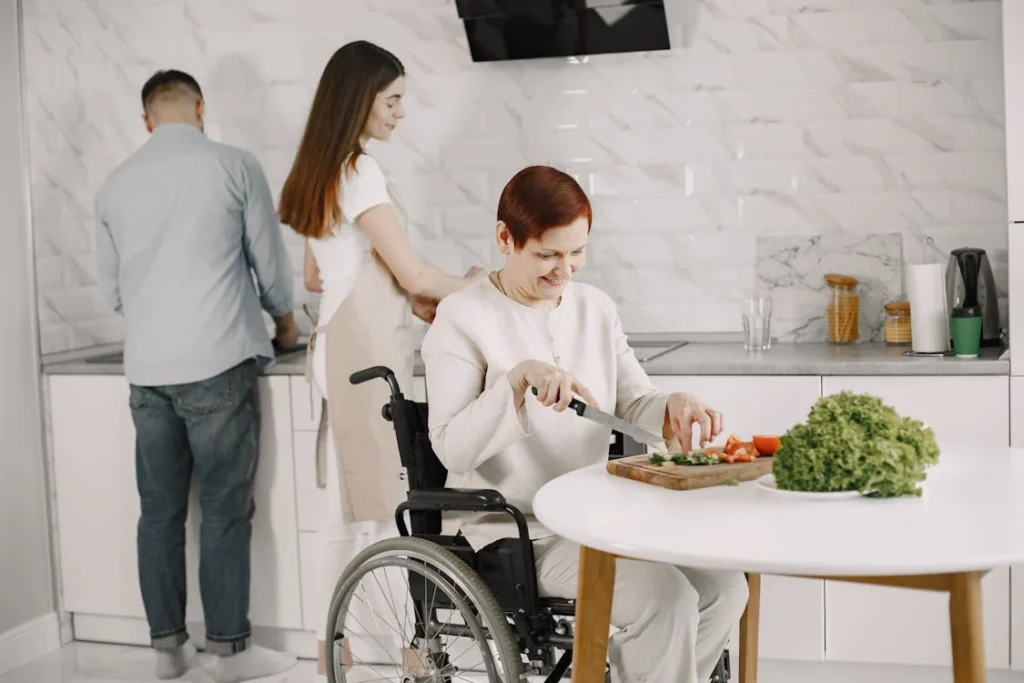
Universal Design in Housing and Urban Development
Creating a truly accessible world means ensuring that homes and urban environments are designed with inclusivity in mind.
Universal design in housing and city planning allows people of all abilities to live comfortably, move freely, and participate in their communities without barriers.
A well-designed home and a thoughtfully planned city improve quality of life for everyone, including seniors, people with disabilities, and families with young children.
Designing Homes for Accessibility and Comfort
A universally designed home is not just about installing ramps or widening doorways—it is about creating a space where individuals of all abilities can live safely and independently.
Many people acquire disabilities later in life due to injury, illness, or aging, and having an adaptable home means they can continue living comfortably without costly renovations in the future.
One of the most important aspects of universal design in housing is step-free access. Entrances without stairs or thresholds make it easier for individuals using wheelchairs, walkers, or strollers to enter and exit their homes effortlessly.
Inside the home, open floor plans provide greater mobility, reducing tight spaces that can be difficult to navigate.
Bathrooms and kitchens are two areas where accessibility matters most. Roll-in showers with grab bars and height-adjustable sinks allow individuals with limited mobility to use these spaces safely.
Touchless faucets, lever-style door handles, and smart lighting systems also make daily tasks easier for individuals with arthritis, limited dexterity, or visual impairments.
Technology is also playing a major role in home accessibility. Smart home automation allows individuals to control lighting, temperature, security, and appliances through voice commands or mobile apps.
These innovations benefit not just individuals with disabilities but also the elderly and people who experience temporary mobility challenges.
Creating Inclusive Cities and Public Spaces
Universal design extends beyond homes and into urban environments. Cities that prioritize accessibility make it easier for people of all abilities to engage in work, leisure, and social activities.
Accessible sidewalks, parks, and transportation systems ensure that individuals with disabilities can navigate their communities safely and independently.
One of the most impactful urban design features is curb cuts, which allow wheelchair users, cyclists, and parents with strollers to move between sidewalks and streets without obstacles.
Public buildings with automatic doors, tactile paving for visually impaired individuals, and ramps instead of stairs create a more inclusive urban landscape.
Public transportation is another area where universal design is crucial. Low-floor buses, wheelchair-accessible metro stations, and real-time digital announcements in multiple formats make commuting more convenient for people with disabilities.
Ensuring that train stations and bus stops have clear signage, tactile indicators, and seating options benefits a wide range of individuals, including the elderly and pregnant women.
The Economic and Social Benefits of Universal Design in Cities
When cities adopt universal design, they create spaces where people of all abilities can contribute to society. Accessible public areas encourage individuals with disabilities to participate in education, employment, and recreational activities without limitations.
Businesses that implement universal design principles, such as accessible storefronts and inclusive hiring practices, benefit from a broader customer base and a more diverse workforce.
Furthermore, when homes and public spaces are built with accessibility in mind, the need for expensive modifications later on is greatly reduced.
Governments that invest in universal design save money in the long run by reducing the costs of disability accommodations, emergency medical interventions, and unemployment benefits for individuals who struggle to access workplaces.
A city designed for everyone is not just a place where people live—it is a place where people thrive.
As more architects, city planners, and policymakers embrace universal design, the world moves closer to becoming truly inclusive, ensuring that every individual, regardless of ability, can enjoy equal opportunities and independence.
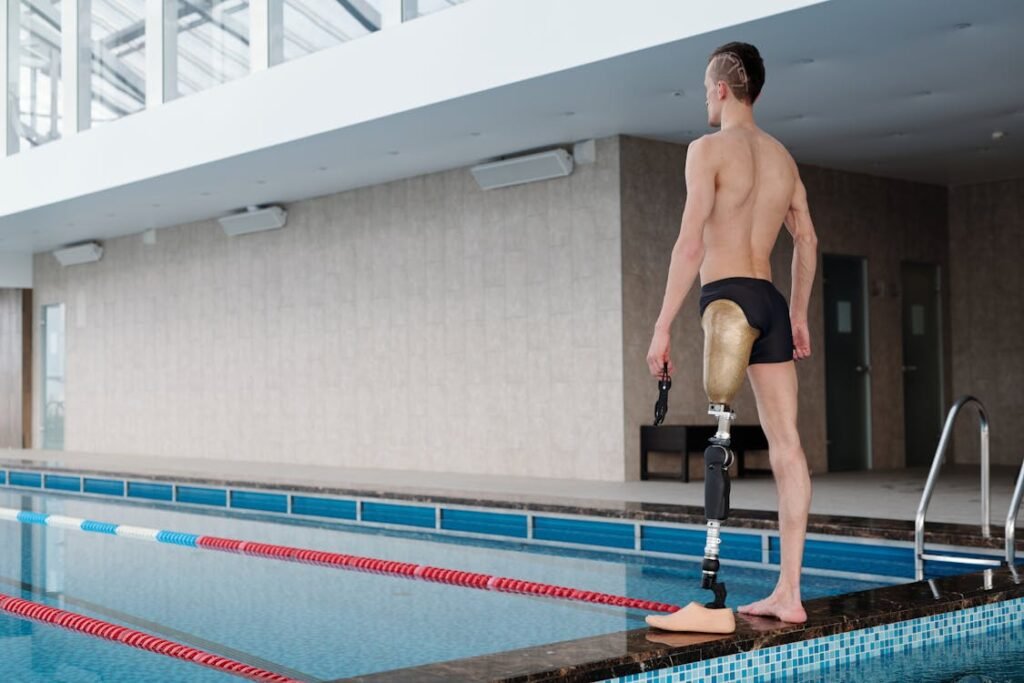
Universal Design in Sports and Recreation
Participating in sports and recreational activities is essential for physical and mental well-being, yet many individuals with disabilities face barriers when it comes to accessing fitness centers, outdoor activities, and competitive sports.
Universal design in sports ensures that everyone, regardless of ability, can enjoy exercise, competition, and leisure without restrictions.
Making Sports Facilities More Inclusive
Sports facilities, including gyms, stadiums, and community centers, must be designed to accommodate individuals with disabilities. Step-free access, wide entryways, and accessible changing rooms allow athletes and spectators with mobility challenges to move around comfortably.
Adaptive fitness equipment, such as treadmills with handrails, wheelchair-accessible weight machines, and adjustable-height exercise stations, ensures that people of all abilities can maintain an active lifestyle.
Many stadiums and sports venues are now incorporating universal design elements such as priority seating for wheelchair users, hearing loops for individuals with hearing impairments, and tactile signage for visually impaired guests.
These modifications not only create a more inclusive experience but also make sports events enjoyable for everyone.
Adaptive Sports and Equipment
The rise of adaptive sports has highlighted the importance of universal design in recreational activities. Innovations in prosthetic limbs, sports wheelchairs, and assistive devices have made it possible for athletes with disabilities to compete at elite levels.
Running prosthetics, such as carbon fiber blades, allow individuals with limb loss to sprint with maximum efficiency, while specialized racing wheelchairs provide increased speed and maneuverability on the track.
Sports like wheelchair basketball, adaptive surfing, and para-cycling have gained global recognition, proving that individuals with disabilities can excel in competitive athletics.
Water sports have also become more accessible thanks to universal design. Adaptive kayaks, floating wheelchairs for beach access, and customized surfboards enable individuals with mobility impairments to enjoy aquatic activities safely.
Skiing and snowboarding have also seen advancements in adaptive technology, with sit-skis, balance supports, and AI-powered exoskeletons helping individuals navigate snowy terrains.
The Importance of Inclusive Recreation
Beyond competitive sports, universal design is also making recreational activities more accessible.
Public parks with sensory-friendly playgrounds, wheelchair-accessible hiking trails, and inclusive community fitness programs encourage people of all abilities to stay active and socialize.
Fitness apps and virtual workout programs are also embracing universal design by offering audio-guided workouts for visually impaired users, adjustable difficulty levels for individuals with limited mobility, and real-time captions for exercise tutorials.
These digital innovations ensure that everyone has access to health and wellness resources, regardless of physical ability.
As universal design continues to expand in the world of sports and recreation, more individuals with disabilities will have the opportunity to lead active, fulfilling lives.
Whether through adaptive equipment, inclusive fitness facilities, or accessible digital platforms, universal design is breaking down barriers and redefining what is possible in sports.
Conclusion
Universal design is not just about accessibility—it is about creating a world where everyone, regardless of ability, can participate fully and independently. Whether in homes, workplaces, cities, technology, healthcare, or sports, designing with inclusivity in mind benefits everyone. By removing barriers before they become obstacles, universal design ensures that people with disabilities do not have to rely on special accommodations but can seamlessly navigate the world around them.
Investing in universal design leads to stronger communities, greater economic opportunities, and improved quality of life for all. It fosters independence, promotes inclusion, and reduces the need for costly modifications in the future. From smart technology to accessible public spaces, every innovation that embraces universal design moves society closer to true equality.
At Robobionics, we are committed to creating solutions that enhance independence and accessibility, such as our advanced prosthetic hand, Grippy™. If you’re looking for innovative assistive technology, contact us today and take the next step toward a more inclusive future.



